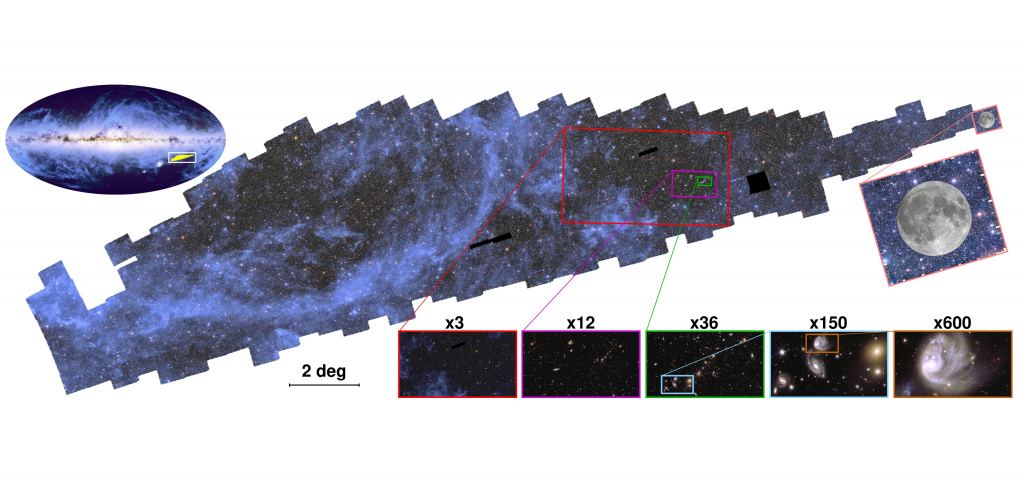On July 1st, 2023 (Canada Day!), the ESA’s Euclid mission lifted off from Cape Canaveral, Florida, atop a SpaceX Falcon 9 rocket. As part of the ESA’s Cosmic Vision Programme, the purpose of this medium-class mission was to observe the “Dark Universe.” This will consist of observing billions of galaxies up to 10 billion light-years away to create the most extensive 3D map of the Universe ever created. This map will allow astronomers and cosmologists to trace the evolution of the cosmos, helping to resolve the mysteries of Dark Matter and Dark Energy.
The first images captured by Euclid were released by the ESA in November 2023 and May 2024, which provided a glimpse at their quality. On October 15th, 2024, the first piece of Euclid‘s great map of the Universe was revealed at the International Astronautical Congress (IAC) in Milan. This 208-gigapixel mosaic contains 260 observations made between March 25th and April 8th, 2024, and provides detailed imagery of millions of stars and galaxies. This mosaic accounts for just 1% of the wide survey that Euclid will cover over its six-year mission and provides a sneak peek at what the final map will look like.
The IAC 2024 session, which took place from October 14th – 18th in Milan, was the 75th annual meeting of the Congress. The session welcomed over 8,000 experts from space agencies, the research sector, and the space industry to come together and discuss the use of space to support sustainability. The mosaic, presented by ESA Director General Josef Aschbacher and Director of Science Carole Mundell during the event, contains about 100 million sources, including stars in our Milky Way and galaxies beyond.
The main objective of the Euclid mission is to measure the hidden influence of Dark Matter and Dark Energy on the Universe. These will hopefully resolve questions that astronomers have been dealing with for decades. It all began in the 1960s when astronomers noted that the rotational curves of galaxies did not agree with the observed amounts of matter they contained. This led to speculation that there must be a mysterious, invisible mass that optical telescopes could not account for (aka. Dark Matter).
By the 1990s, thanks to observations made by the venerable Hubble Space Telescope, astronomers also noticed that the rate at which the Universe has been expanding (the Hubble-Lemaitre Constant) was accelerating with time. By observing the shapes, distances, and motions of billions of galaxies, Euclid‘s 3D map will provide the most accurate estimates of galactic masses and cosmic expansion over the past 10 billion years. Zooming very deep into the mosaic (see image below), the intricate structure of the Milky Way can be seen, as well as many galaxies beyond.
Another interesting feature is what looks like clouds between the stars in our galaxy, which appear light blue against the background of space. This is the gas and dust of the interstellar medium (ISM), which is known on a galactic scale as the “galactic cirrus” (because of its resemblance to clouds). Euclid‘s super-sensitive optical camera—the VISible instrument (VIS), composed of 36 charged-coupled devices (CCDs) with 4000 x 4000 pixels each—can see these clouds as they reflect optical light from the Milky Way. Said Euclid Project Scientist Valeria Pettorino in an ESA press release.
“This stunning image is the first piece of a map that, in six years, will reveal more than one-third of the sky. This is just 1% of the map, and yet it is full of a variety of sources that will help scientists discover new ways to describe the Universe.”
As noted, the mosaic shows only 1% of what Euclid will observe during the course of its six-year mission. In just two weeks, the observatory covered 132 square degrees of the Southern Sky in pristine detail (more than 500 times the area of the full Moon). Since the mission began routine science observations in February, 12% of the survey has been completed. By March 2025, the ESA will release 53 square degrees of the survey, including a preview of the Euclid Deep Field areas. This will be followed by the release of the first year of cosmology data sometime in 2026.
The Euclid Consortium (EC) consists of more than 2000 scientists from 300 institutes in Europe, the USA, Canada, and Japan and is responsible for providing the mission’s instruments and data analysis.
Further Reading: ESA

